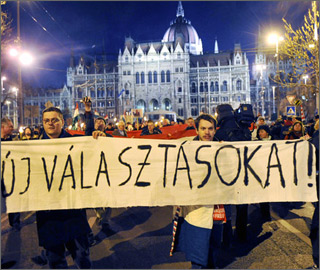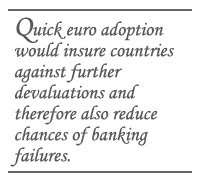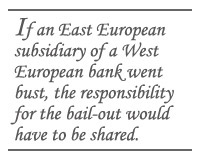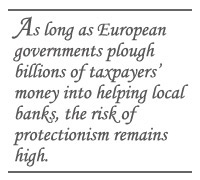The EU Can Ignore Eastern Europe at Its Own Peril
The EU Can Ignore Eastern Europe at Its Own Peril

LONDON: The glow of the G-20 summit and some less-than-awful economic data have brought some faint signs of optimism to Europe. But in the European Union’s Eastern member-states, the risk of economic turmoil and political backlash is still tangible. Unless the Europeans address the threat with appropriate financial measures and resist any protectionist urge, trouble in the East could delay the recovery of all of Europe.
On April 6th it emerged that the International Monetary Fund would advise Central and Eastern European countries to adopt the euro, unilaterally and without meeting the EU’s strict criteria for the single currency, if necessary. This recommendation – in a leaked report written in March – served as a stark reminder that some of the EU’s newer member-states are still in trouble. Most East European economies are in deep recession. Their export markets in the West are collapsing. Their banks – mostly owned by big West European ones – are vulnerable as borrowers and businesses struggle to repay their loans. Since many of these loans were taken out in euros and Swiss francs, the devaluations of East European currencies have significantly increased the risk of default.

Quick euro adoption would insure countries against further devaluations and therefore also reduce chances of banking failures. Economically, the euro would be a great safe haven for the small Baltic countries, which are already fixing their currencies to the euro, but not for the likes of Hungary or Poland where flexible exchange rates may be needed to restore export competitiveness. In any case, unilateral adoption of the euro is a political no-go because the existing eurozone members and the European Central Bank are categorically against it. They fear that the inclusion of poorer and unstable-looking economies could undermine the stability of the single currency at a time when there are already growing doubts about the sustainability of the eurozone.
Even without a fast-track into the euro, there are lots of things that the EU is doing to help its newest members. According to IMF estimates, “emerging Europe” (including the Balkans and Turkey) must find almost $500 billion this year to roll over its external debt and finance its external deficits. At least a quarter of this will probably have to come from international lenders, such as the IMF and the EU. The EU has already raised its own emergency fund from €12 billion in 2008 to €50 billion ($66 billion) today. It has used some of this money to co-finance large loan packages for Hungary, Latvia and, more recently, Romania, under the auspices of the IMF.

The European countries have also pledged a contribution of $100 billion to the tripling of the IMF’s resources that was agreed at the G-20 summit. They did so mainly with Central and Eastern Europe in mind. When it comes to emergency funding, the EU is right to work through the IMF, not seeking to replace it. The European Commission (the EU’s executive body that administers the emergency funds) does not have much experience with imposing the kind of economic conditionality that usually comes with large balance-of-payments loans.
The Europeans need to concentrate on other things, namely reducing risks in East European banking sectors and keeping markets open. Two of the key ingredients to the phenomenal economic success of Central and Eastern Europe since the 1990s have been their integration into the EU single market and financial liberalisation. Now this process of opening up seems to have left the East European countries exceptionally vulnerable to the global downturn.

Since the early 1990s, the new members have thrown open their capital accounts, welcomed foreign companies and sold most of their local banks to finance houses from Austria, Belgium, Germany, Italy and Sweden. So far the new members have avoided big banking crises. But people in these countries are complaining that West European banks are exacerbating their economic situation by cutting credit lines to their East European subsidiaries. Some East Europeans worry that if a parent bank got into serious trouble, it could withdraw capital from its East European subsidiaries to patch up holes at home; or that it might have to fire-sell these subsidiaries; or – if no buyer stepped forward – let them fail. Government demands that banks propped up by state money should “lend local” are as understandable as they are dangerous. The loans that Austrian banks have made in Eastern Europe account for approximately 70 percent of Austrian GDP by some measures. The shares are closer to 10 per cent for countries such as Greece and Sweden but that is still a risk to their banking sectors.
If an East European subsidiary of a West European bank went bust, the responsibility for the bail-out would have to be shared. West European countries did not prevent their banks from lending irresponsibly across borders while some East European countries foolishly allowed people and businesses to binge on foreign currency loans. The EU is ideally suited to foster the kind of co-operation that is needed to plan for a cross-border banking bail-out. Money from the existing IMF/EU emergency packages can be used to re-capitalise banks in Eastern Europe. And the EU’s other lending institutions, such as the European Bank for Reconstruction and Development and the European Investment Bank, have put together a €26 billion package to help East European banks and businesses.

It is equally important that the richer West European countries resist the temptation of protectionism. For many of the new member-states, exports account for 80-90 per cent of GDP (for the US, the share is 12 percent). By far the biggest market for all of them is the eurozone, which is now in recession. Any signs of protectionism in Western Europe would make the situation in Central and Eastern Europe a lot worse. The new members have not only opened up to trade, they have become part of pan-European supply chains, especially in the automotive sector. Car production in this region doubled between 2000 and 2007, as western carmakers shifted manufacturing there. When global automotive demand collapsed, conveyor belts in Eastern Europe were idled. Many in Eastern Europe now question whether it was wise to get so deeply integrated in global markets over which they have no control. Doubts turned into outrage when Nicolas Sarkozy, the French president, suggested that French auto makers could only expect state support if they relocated production from Eastern Europe back to France. President Sarkozy had to take back his demand and the European Commission has so far done a good job of defending the integrity of the EU’s single market. But as long as European governments plough billions of taxpayers’ money into helping local banks and businesses, the risk of protectionism remains high.
The early months of 2009 saw riots in Latvia, Lithuania and Bulgaria. Governments in Latvia, Hungary and the Czech Republic collapsed under accusations of mishandling the economic crisis. The risk of large-scale political unrest appears small but there are stirrings of social discontent across the East European region. The real risk is that the East Europeans – if left alone with their financial woes and faced with protectionism in some other EU countries – could start questioning their growth model of liberalization and market integration. If the EU mishandles the crisis in the East, this important region could emerge with its growth prospects impaired, its politicians eurosceptic and its workers packing up to move west.
Katinka Barysch is deputy director of the Centre for European Reform.